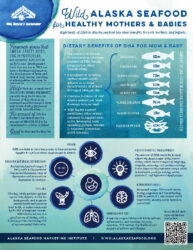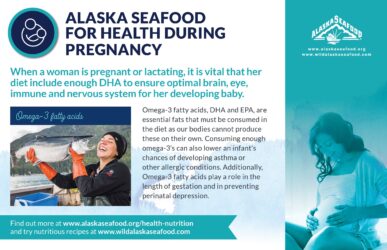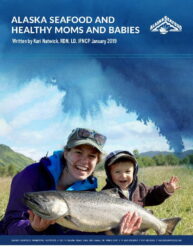Moms & Babies


Alaska Seafood for Healthy Moms and Babies During Pregnancy
When a woman is pregnant or lactating, it is vital that her diet include enough DHA to ensure optimal brain, eye, immune and nervous system for her developing baby.
Omega-3 Fatty Acids
Omega-3 fatty acids, DHA and EPA, are essential fats that must be consumed in the diet as our bodies cannot produce these on their own. Consuming enough omega-3’s can also lower an infant’s chances of developing asthma or other allergic conditions. Additionally, omega-3 fatty acids play a role in the length of gestation and in preventing perinatal depression.
- The omega-3 fatty acid DHA is especially important for expectant mothers and developing babies.
- DHA remains important beyond delivery as DHA is critical for brain development from pregnancy until the age of two.
- Guidelines recommend that women consume 200 mg per day of DHA during pregnancy/breastfeeding.
- Consuming at least four ounces of seafood rich in omega-3’s, twice per week to meet the needs of both mom and baby.
- Diets should include wild Alaska seafood sources high in omega-3’s such as salmon, sablefish, herring, crab, and rockfish,
- Many Alaska seafood species are low in mercury, and are also high in selenium, which prevents mercury from acting in the body.
Alaska Seafood and Infant Nutrition
The omega-3 fatty acid DHA is essential for the growth and development of a baby’s central nervous system, brain, and the retina in utero.
Infants and toddlers should consume optimal levels of DHA through breastmilk and a diet containing foods rich in DHA including wild Alaska salmon, sablefish, herring, crab, and rockfish at least twice a week.
- Adequate DHA consumption improves visual acuity as well as cognitive development in children.
- The third trimester is when the most significant amount of brain development occurs, and DHA is transferred at an even higher rate from mother to baby.
- For optimal DHA intake, a mother should consume 200 mg of DHA per day during pregnancy/ breastfeeding.
- Infants and toddlers should also consume optimal levels of DHA through breastmilk and a diet containing foods rich in DHA.
- Including wild Alaska seafood high in omega-3 fatty acids such as salmon, sablefish, herring, rockfish, and cod at least twice a week will help to ensure optimal brain, nerve and retinal development in children.



